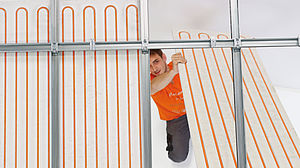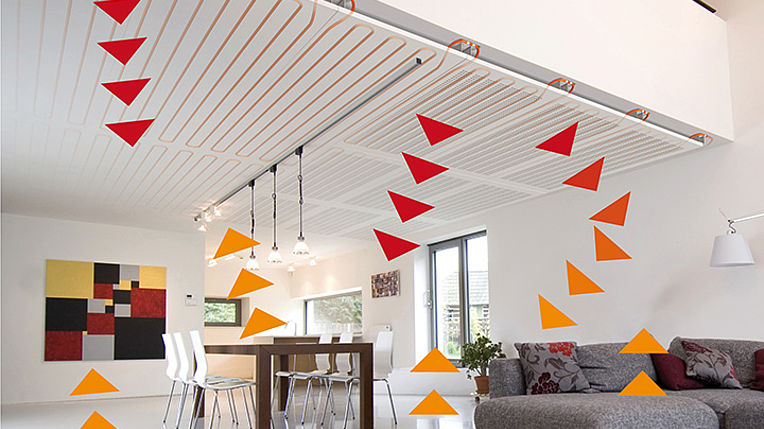HOW CEILING HEATING WORKS
Ceiling heating radiates the room and heats it to a comfortable temperature. It is laid over a large area, which means that it can work with low flow temperatures. That saves on energy costs and leaves plenty of space for the interior design. Find out more about how ceiling heating works.
- How does ceiling heating work?
- Flow temperatures for ceiling heating
- When ceiling heating makes sense
- Comparison between ceiling heating and standard radiators
- Ceiling heating with acoustic surface
- The structure and construction height of ceiling heating systems
- Ceiling heating in pitched roofs
- Advantages and disadvantages of ceiling heating
- Ceiling heating installation
- Cooling with ceiling heating
- Types of ceiling heating
- How quickly does ceiling heating warm the room?
How does ceiling heating work?
Ceiling heating radiates the room and heats it to a comfortable temperature. It is laid over a large area, which means that it can work with low flow temperatures.
Ceiling heating is a surface heating system, and uses the entire surface are to emit heat. Hot air rises, so does ceiling heating make any sense? Yes, it does! Unlike radiators, they heat the room with cosy, radiant heat. Due to the low surface temperatures, there is hardly any convection.
Here, physics can provide an explanation. Radiation transmits the heat via electromagnetic waves. The most important source of radiant heat is the sun. The rays spread out at right-angles to the surface – in other words, from top to bottom for ceiling heating. When the waves hit a solid object, such as furnishings, the floor or a human body, they are converted into heat. The solid objects emit the energy absorbed into the room as heat.
Flow temperatures for ceiling heating
As a heat transfer medium, water is pumped through the pipes. Thanks to the large area over which the heating is laid, it is sufficient for the water to be heated to a maximum of 38 °C (depending on the outside temperature). In comparison, conventional radiators require a flow temperature of up to 60°C. Due to their smaller surface area, they only emit heat in a localised way.
At the surface, the ceiling heating temperature is between 23 °C and a maximum of 34 °C. These temperatures feel very comfortable.
Low-temperature ceiling heating can be used with room heights of between 2.5 and 3.5 metres. Here, the radiant heat can unfold in the best possible way - with flow temperatures of between 26 and 38 °C. For rooms with a height of over 3.5 meters, a higher flow temperature is required. We also recommend a combination of a ceiling heating and wall heating system.
When ceiling heating makes sense
When renovating old or listed buildings, the beautiful floors need to be kept. In new buildings, you don’t want to select the floor covering on the basis of whether it is suitable for floor heating. In both cases, radiant ceiling heating is the best solution. It also leaves plenty of space for the interior design.
Ceiling heating with acoustic surface
In offices, but especially also in public buildings or hospitals, the environment is stressful for the human ear. Ambient noise is unpleasant and lowers productivity. This is where ceiling heating with noise dampening acoustic function comes in.
The acoustic ceiling reduces the reverberation time, thanks to perforations in the gypsum fibre boards. The holes absorb the surrounding noise: the larger the acoustic surface, the less the reverberation time and the more comfortable the working environment.
The structure and construction height of ceiling heating systems
Ceiling heating can be installed in drywall construction and under plaster.
If ceiling heating is installed in drywall construction, 18 mm gypsum fibre boards with integrated heating pipes are screwed to a substructure on the ceiling which is made of wood or metal. The construction height of the finished heating ceiling is around 80 mm.
The aluminium multi-layer composite pipes are attached directly to the ceiling via rails. The construction height of the radiant ceiling heating, including plaster, is around 27 mm.
Ceiling heating in pitched roofs
In loft apartments, there is often very little free space, and what is available is needed for furniture and pictures. A radiator is a nuisance and takes up an unnecessary amount of space.
By contrast, ceiling heating is invisibly integrated into the sloping roofs and heats the room with comfortable radiant heat. The flexible surface heating system fits perfectly into complex roof structures.
Advantages and disadvantages of ceiling heating
- It emits radiant heat, with hardly any convection. It is silent and free of forced air.
- Ceiling heating is invisible: furniture and pictures do not need to be taken into account when planning the interior space.
- The ceiling heating can also be installed at a later stage.
- Compared to floor or wall heating, ceiling heating can emit heat unhindered and is not blocked by thick carpets or large items of furniture.
If you compare the purchase costs with a standard radiator, they are higher for ceiling heating. However, during ongoing operation, the energy costs of a water-based ceiling heating system are up to 25% lower than the heating costs of convection heating. This means that surface heating pays off within just a few years.
Also, the ceiling heating is silent and does not require forced air, which is why it can also run at night.
Ceiling heating installation
The flexible Variotherm cooling ceiling and ceiling heating is simple and quick to install, like in standard drywall construction.
The flexible ModulePanels are mounted in drywall construction and can also be installed at a later stage. Metal and wood constructions on the ceiling are suitable substructures.
The ModulePanels can be painted with standard paint. Ceiling cooling is quick and easy to install. Find out more about how ceiling heating is fitted.
Cooling with ceiling heating
The radiant energy not only cools the air, but also warms up the human body in a pleasant and healthy way.
If the temperatures in summer become unbearably hot, the ceiling heating can also be used for cooling. Cool water flows through the heating pipes at a temperature of 16-20 °C.
Since the cooling ceiling tempers the rooms using radiant exchange, there is hardly any convection and therefore no forced air. That’s why ceiling cooling is the perfect alternative to an air conditioning system.
Types of ceiling heating
There are two types of ceiling heating:
- water-bearing heated ceilings
- electrically operated ceiling heating
Water-bearing surface heating systems can operate on very low flow temperatures (26 to 38 °C). In many cases, surface heating is combined with a heat pump. This reduces energy costs and protects the environment.
With surface heating, the room air temperature can be reduced by up to 2 °C compared to convection heating systems. Even so, the room climate feels comfortable. Around six percent of heating costs can be saved for every degree by which the room air temperature is reduced.
Electric heating panels may be cheaper to buy, but they need a large amount of energy during ongoing operation.
Another advantage of water-bearing ceiling heating compared to an electrically operated ceiling is that the water-bearing heating can also be used to cool the room in the summer. Instead of warm water, cold water circulates through the aluminium multi-layer composite pipes. That’s it!
Which heating system is the right one for you?
There are many different solutions available for heating your rooms, depending on the nature of the building, the sources of heat or the required interior design. However, which is the right one for you? Variotherm offers individual solutions with a number of different heating systems. If you use the walls or ceiling to heat in the winter, you can use the same system to cool rooms during the summer.
How does ceiling heating work?
Ceiling heating uses the entire surface for heat output and transfers the heat using electromagnetic waves. These rays spread out at right-angles to the surface – in other words, from top to bottom for ceiling heating. If the rays hit a solid object, the energy is converted into heat and emitted into the room.
Does it make sense to combine surface heating systems?
Heating via the floor, walls or ceiling makes the room feel comfortable. We recommend a combination of floor, walls and ceiling. In general, walls offer the largest exchange surface, which is why wall heating systems make the radiant heat easy for people to feel. On hot summer days, wall and/or ceiling heating is best suited for cooling.















